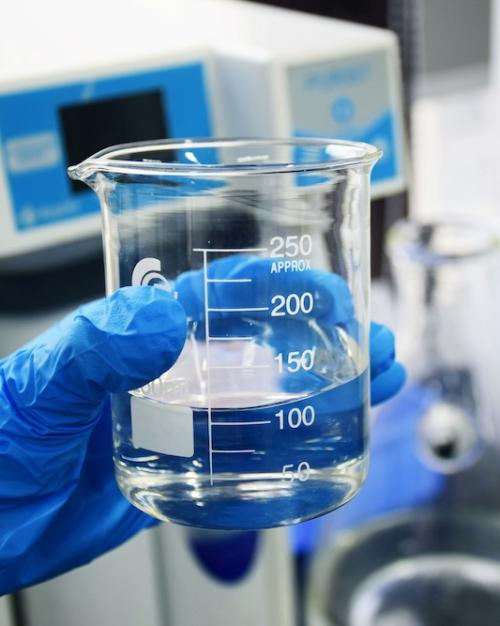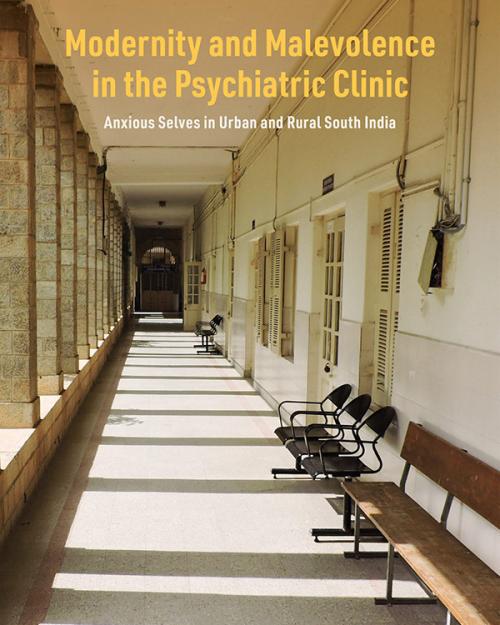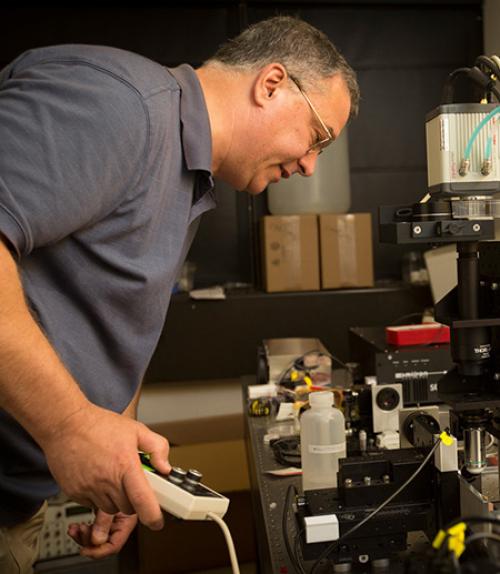One need not travel millions of light-years to explore one of the greatest scientific frontiers of the 21st century. It is mere millimeters that modern-day pioneers are attempting to journey in order to better understand the mystery of how the human brain is wired to produce thoughts, feelings, dreams, memories and actions.
As long as the inner-workings of the brain remain poorly understood, so too will disorders such as Alzheimer’s disease, Parkinson’s disease, autism, epilepsy, schizophrenia and depression. But unlike astronomers who use telescopes, rockets and satellites to view the billions of stars in our galaxy, neuroscientists lack the technology to view all of the brain’s billions of neurons communicating with each other at any given moment.
Cornell Neurotech—a joint initiative launched in 2015 by Cornell Engineering and Cornell’s College of Arts & Sciences—aims to build powerful new tools that can be used to map the individual cells and complex neural networks that change from moment-to-moment within the brain. The challenge is daunting, but recent technological breakthroughs serve as prime examples of how Cornell researchers are already providing unprecedented glimpses into the very origins of the human experience.
FROM HUMBLE BEGINNINGS
The Cornell Neurotech collaboration was born from humble beginnings when several faculty members began meeting informally in the Physical Sciences Building to discuss their work and share research opportunities regarding neuroscience and technology.
The group had been encouraged by Paul McEuen, co-director of the Kavli Institute at Cornell—which not only provided nominal funding for the monthly meetings, but since 2011 had also been pushing a much larger national research initiative to substantially invest in studies of the brain.
It wasn’t until 2013 when the push for a national program came to fruition with the launch of the BRAIN (Brain Research through Advancing Innovative Neurotechnologies) Initiative—a large-scale effort initiated by President Barack Obama to accelerate the development and application of neurotechnologies.
McEuen had been invited to help develop the BRAIN Initiative’s goals and priorities along with fellow Kavli member Chris Xu, a professor of applied and engineering physics, and so the two brought their intimate knowledge of the program back to campus.
The small group of Cornell researchers, helped by Andrew Bass, a professor and senior associate vice provost for research, looked to turn their grassroots effort to share research into a more formal program to strategically take advantage of the national funding that was becoming available. That break came when philanthropist Stephen Mong ’92, M.Eng. ’93, M.B.A. ’02, attended one of the group’s meetings and, seeing an opportunity to leverage Cornell’s strengths in a cross-campus collaboration, provided resources through the Mong Family Foundation to launch a formal version of the group—Cornell Neurotech.
Xu would be named co-director along with Joseph Fetcho, a professor of neurobiology and behavior who had been using see-through zebrafish to study how brain neurons activated particular behaviors. Cornell Neurotech’s core advisory group consists of a dozen members. “We cherry picked some of the very best people at Cornell who had some interest in this problem,” said Fetcho.
THE CHALLENGE
To better understand the challenge faced by today’s neuroscientists, Fetcho says to think about the brain like a toy car that winds up and propels itself. Now imagine that toy car being smashed to pieces with a hammer.
“If I gave you those bits and said ‘fix this car,’ it’s not especially easy to do because you don’t know how it worked to begin with,” said Fetcho. “This is a car with maybe a dozen parts to it. Now imagine a human brain where you have 300 billion parts with 300 trillion connections among the parts. How do you even begin to attack the problem?”
Xu applies the analogy to attempting to study brain disorders, saying “a lot of work tries to understand depression, for example, and of course that is the goal. But in some sense, we have no clue how things are functional. We don’t even know what a healthy brain looks like.”
What scientists do know is that the brain transmits information to the rest of the nervous system using billions of specialized cells called neurons, which communicate with each other using electrical impulses. Scientists have no way to directly view all of these impulses in real time, but if they did it would allow them to create a blueprint to the brain, mapping where and when each neuron activates in conjunction with a behavior the brain is telling its host to do. It would also allow physicians to examine why brain disorders occur, and could potentially lead to cures or preventative measures. Researchers will tell you this blueprint is the holy grail of neuroscience.
MULTIPHOTON MICROSCOPY
Scientists aren’t totally in the dark when it comes to catching glimpses of the brain’s neural activity. Researchers like those participating in Cornell Neurotech have gained unprecedented views and understandings of the activity of brain neurons using a variety of technologies and techniques engineered on the Ithaca campus.

One of the earliest breakthroughs in modern-day brain imaging was developed in the lab of Watt Webb, an emeritus professor of applied and engineering physics at Cornell who, in 1990, worked with a team of researchers to invent and patent the two-photon microscope. The technology could non-invasively excite natural fluorescence and dyes within living tissue using two special laser beams focused on a single point. It would be several years before Webb and other researchers would realize the full potential the device possessed for biological applications. Once they did, the microscope quickly revolutionized the field, combining advanced techniques from physics and biology to allow scientists to examine some of the smallest structures of the brain. Even today the microscope is recognized as being so essential, three of the students who had worked in Webb’s lab—Winfried Denk Ph.D. ’89, Karel Svoboda ’88, and David Tank M.S. ’80, Ph.D. ’83—were bestowed the 2015 Brain Prize, the most prestigious award in all of neuroscience.
But it would be another one of Webb’s star students—Chris Xu—who would take the technology to unprecedented levels, pushing the depth limits of how far scientists could see inside tissue. Working in Webb’s lab in 1995, Xu demonstrated a three-photon microscope using the same concept as the two-photon microscope, but with a laser that used a longer excitation wavelength. It took 20 years for Xu to perfect the apparatus and, together with Chris Schaffer, a professor of biomedical engineering, publish a study showing high-resolution, three-dimensional images of neurons sitting inside the subcortical region of a live mouse brain, deeper than any two-photon microscope had ever viewed.
Xu has also worked to miniaturize the technology by shrinking the microscope so it can be inserted safely into a living being. By using fiber optics to house the multi-photon technology in the tiny end of a thin endoscope, Xu gave researchers a new tool to see inside living organisms—a technology with applications well beyond neuroscience. Doctors may one day use a similar endoscope to directly image organs for cancer.
Despite the promising potential, Xu says further technology development is needed. “I can see that there is a limitation, eventually, for optics. In a mouse brain’s hippocampus region I can reach one millimeter, maybe if I keep pushing I could reach two. A mouse brain is about eight millimeter thick. Can I reach all eight? Probably never,” concedes Xu.
LIGHT SHEET MICROSCOPY
As multi-photon microscopy began to gain popularity, Fetcho was one of the earliest neurobiologists to apply it by imaging the activity of neurons in the brain. He decided to take a risk and abandon a research project that had already been funded and instead investigate how microscopy could be used on zebrafish. When the tropical, fresh-water fish are young, they have a transparent exterior, making them popular research specimens among biologists. Fetcho used microscopy to image these fish, becoming the first neurobiologist to glance at the neural activity of any intact, live vertebrate.

While the breakthrough was a major victory, Fetcho wasn’t satisfied. The microscope was giving him snapshots of only a portion of the brain. Years later, a colleague of Fetcho’s was investigating functional imaging at the Janelia campus of the Howard Hughes Medical Institute. Fetcho had showed his colleague some of the approaches his lab developed to study zebrafish, which the Janelia scientist dramatically extended to develop a new system that could quickly image the activity of all of the neurons in the zebrafish brain. Like the microscope Fetcho had been using, the laser would go inside the specimen, but instead of exciting a single point of interest, a sheet of light would excite the entire specimen. The portion of the microscope reading the light would rapidly scan horizontally to capture the entire sheet. Engineers at the institute were able to collect data fast enough that instead of seeing a small portion of the zebrafish, a semi-instant snapshot of neurons throughout its entire body could be recorded. The fish’s entire neuro activity could now be seen, frozen in time. The new microscope was introduced to the world in 2011.
“All that was built on an edifice that started with people at Cornell because Cornellians were the first ones to show you could do this at all,” said Fetcho.
Fetcho had intimate knowledge of the project, but couldn’t afford the $800,000 price tag that came with the first-of-its-kind microscope. So, he scrapped around for parts and built a $200,000 version that worked just as well.
In more recent years, technological advances have improved the images produced by the microscope, but like Xu, Fetcho longs for new technology that will provide an even deeper understanding of the brain’s mysterious circuitry.
NEXT GEN SOLUTIONS
Fetcho’s light sheet microscope allowed him to start piecing together what whole populations of neurons were doing inside zebrafish. But brain neurons are not static, and so the snapshots obtained by Fetcho are only providing a small piece to the puzzle.
“You really need to be able to watch on-the-fly, live, how the circuit’s working and then how that circuit dynamically changes as behavior evolves,” said Fetcho.
This is exactly the type of challenge Cornell Neurotech will tackle, and Xu is already getting a head start. His multi-photon microscope and Fetcho’s light sheet microscope both measure neural activity by monitoring the influx of calcium that neurons take in when trading information with each other. While the calcium is easiest to detect because it binds with luminescent dyes that image well, measuring voltage provides a better picture because it gives a direct look at each neural activity, even sub-threshold synaptic communications that aren’t detectable with calcium.
Xu says while his optical microscopes can measure voltage, the data the sensors acquire is limited because they’re not bright enough to measure deep neurons in the mouse brain. A technique known as electrophysiology, in which voltage is measured through electrodes placed in the brain, corrects that problem, but according to Xu “you have to stick something in the brain, which is always invasive. And electrical doesn’t give you single-cell resolution when scaled up to include many neurons. It’s really hard to get down to which particular cell gave you an activity,” he said.
Xu says the solution may lie at the interface of optical methods and nanotechnology, a direction pushed by McEuen and the Kavli Institute. To get a good signal out of the voltage, any nano-device developed for brain imaging would have to have amplification, which presents the challenge of incorporating a source of energy.
“The idea is it’s a smart implant and hopefully autonomous with no wire attached to it. And it can detect activity and reel information back out,” said Xu. Such a micro-sensor specifically designed for imaging neurons doesn’t exist, so Xu and McEuen have turned to Alyosha Molnar, an associate professor of electrical and computer engineering, who has been working on microelectrode array technology.
By combining compact amplification and digitization of neural signals with “angle-sensitive pixels,” essentially lensless-camera technology that can capture 3D images, Molnar’s research group is building electrode arrays for simultaneous opto-electronic recording of neural tissue. He’s embedding in the technology techniques he has developed for low-power, low-noise neural recording to ultimately develop implantable opto-electronic neural probes that would accomplish exactly what Xu has described.
“It’s promising. It gives a path perhaps beyond optics and beyond electrical recording,” said Xu. He adds that he and Molnar will need to show convincing data that imaging with this device is a fruitful direction to travel in order to prove the feasibility and further pursue the research.
GENERATING EXCELLENCE AT CORNELL
Researchers like Xu and Molnar trying to prove a new technology are caught in somewhat of a Catch-22. Scientists need to show their work has great potential in order to receive funding, but it takes funding to build a prototype and perform experiments to show the technology’s promise.
That’s where Cornell Neurotech comes in. Some of the funds used to establish the initiative are designated for seed grants to support collaborative solutions or solve particular problems that will allow groups to move forward with a technology.
“The goal is to seed research so that they can get to the point where they can demonstrate that this is major. It’s proof of principle,” said Fetcho, who adds that without the seed funding, researchers may be averse to pursuing creative ideas. It was a situation he personally faced before risking his own time and money on zebrafish.
But Cornell is uniquely positioned to make breakthroughs, according to Schaffer, who has worked with both Xu and Fetcho. “The strong ties between researchers in the physical sciences, engineering and in the life sciences at Cornell, as exemplified by the highly-interdisciplinary makeup of Cornell Neurotech,” said Schaffer, “enables our work to not just focus on answering established neuroscience questions with new or existing technologies, or on developing new technologies that neuroscientists say they need. Instead, we can work together to develop the question and tool simultaneously, with each informing the other, enabling us to go after more important questions and develop more targeted tools.”
For now, Cornell Neurotech will only be making grants available to Cornell researchers, with the advisory group deciding which projects receive funding. The group will also be inviting leading engineers and neuroscientists from other institutions to give public lectures on campus, with the goal of raising visibility for Cornell’s strength in the neurotechnology field. Funding has also been designated to attract prominent faculty to the university.
“We have points of excellence, but can we generate an area of excellence,” asked Xu. He and his colleagues think it can be done, agreeing that Cornell is uniquely positioned to make research breakthroughs because of the interdisciplinary nature of the university and interactions between its neurobiologists and engineers.
“It will take the capacity of the College of Engineering and the capabilities of the physical scientists in Arts & Sciences to put this together,” Mong told the Cornell Chronicle after Cornell Neurotech was announced in October.
Both Xu and Fetcho say Cornell’s strength in computer science and information engineering can also boost the university’s reputation in neuroscience because of the need to manage the large amount of data new technologies will generate.
“Data sets are going to be on a scale that you need someone to write algorithms to help make sense of it and extract relevant information,” said Fetcho.
“It’s kind of mind boggling. The data I think will be in the…,” added Xu as he stopped to sketch a calculation on paper. “…30,000 terabytes for one mouse.”
THE CUSP OF DISCOVERY
Cornell Neurotech is beginning to seed research projects during a fiscal year that the BRAIN Initiative is handing out $85 million from the National Institutes of Health, which says the last decade has seen a number of landmark discoveries that make now an opportune time to unlock the mysteries of the brain. Substantial funding is being committed from other federal agencies such as the National Science Foundation, the Defense Advanced Research Projects Agency, the Intelligence Advanced Research Projects Activity and private institutions such as the Howard Hughes Medical Institute and the Allen Institute for Brain Science.
“The science has really come to maturity,” said Xu. “We’re on the cusp of being able to make a major contribution.”
The focus on neurotechnology also comes at a time when brain disorders have become a more prominent health challenge in society, both in terms of cost and human suffering. With the average lifespan increasing, so is the prevalence of diseases such as Alzheimer’s and Parkinson’s. Medical professionals are also getting better at diagnosing disorders such as autism and depression, each one with an emotional and monetary cost on individuals and society as a whole. A 2013 study in the New England Journal of Medicine placed the annual cost of healthcare for dementia between $157 billion and $215 billion, with Medicare covering approximately $11 billion of the cost.
Fetcho believes there are solutions to many of the brain disorders at the heart of these social and economic challenges, and attempting to understand them better through a new Cornell initiative is “ironic in a way, because some of the best stuff ever at these interfaces was done here,” said Fetcho, referring to the research done by Webb in the 80s and 90s. Cornell’s neurotech history will come full circle when the three Brain Prize winners from Webb’s lab return to campus in September to speak at a kickoff symposium for Cornell Neurotech.
Perhaps one of them will remind symposium goers of a saying Webb used in his lab: “tentanda via est,” which he translated from Latin as, "to experiment is the true way."
This article originally appeared in Cornell Engineering magazine.




